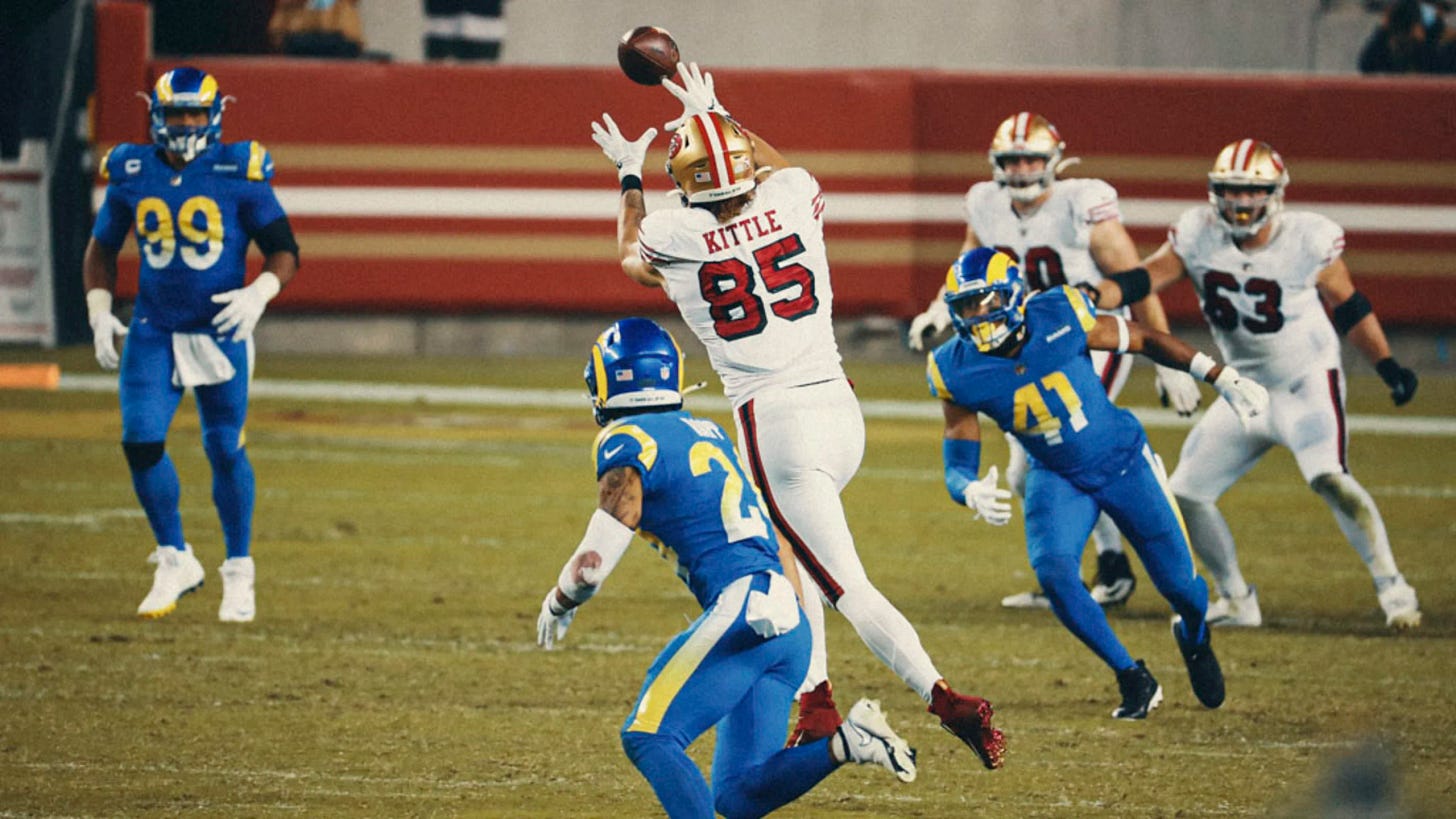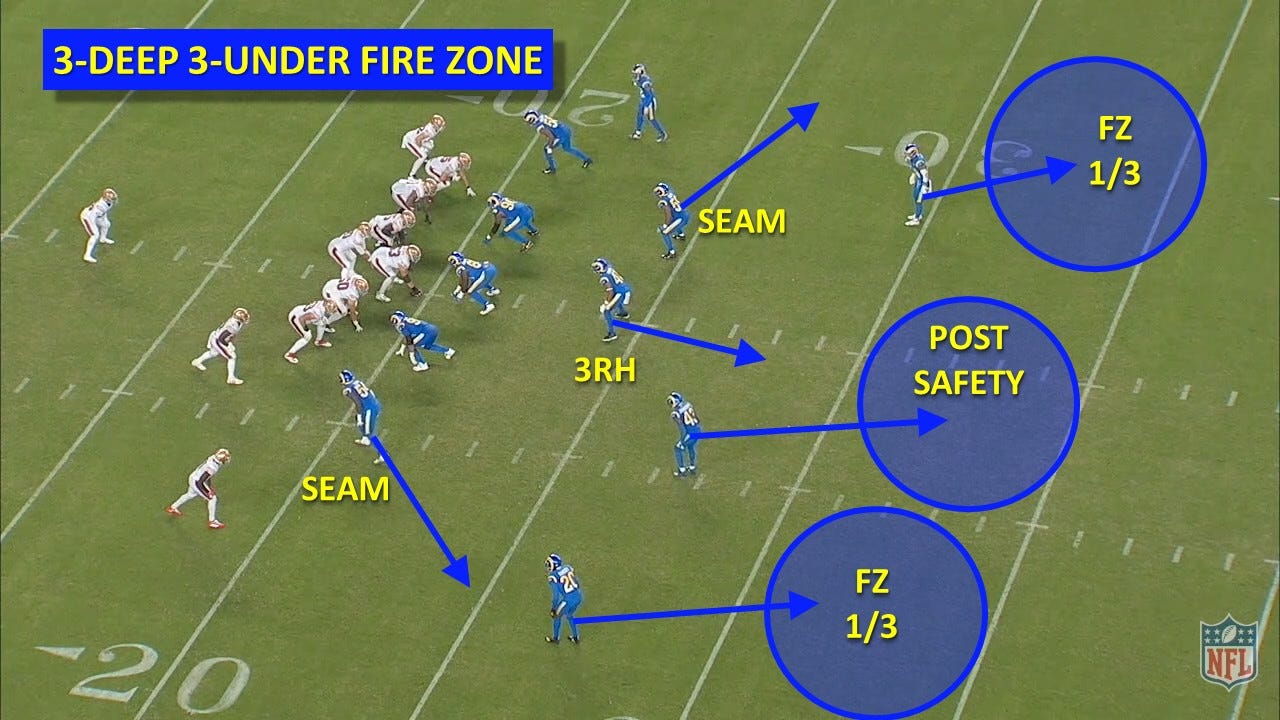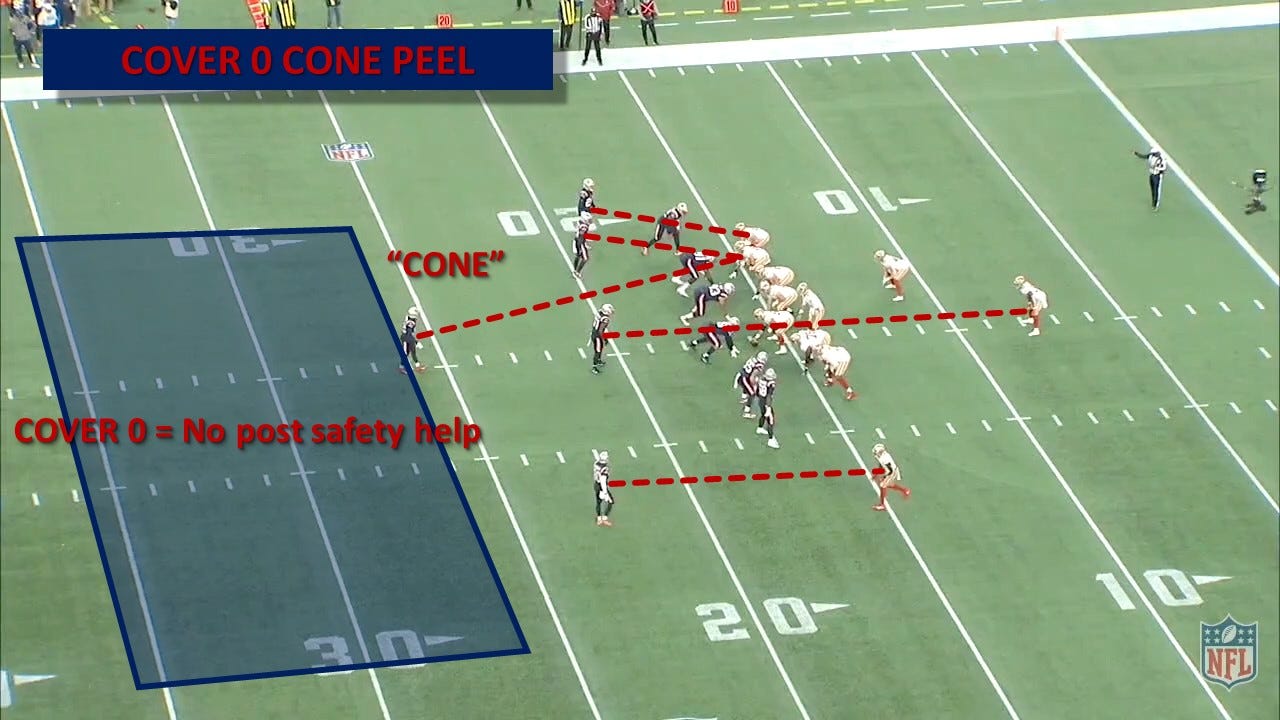49ers film room part 2: play action drift swirl
Part 2 of this play action concept series looks at the "drift swirl" concept.

In the first article of this series, we took a look at how the 49ers call their “drift” play action passing game concept and the audible they use to get to it at the line of scrimmage. Today, we’ll look at another way the 49ers pair the route versus various 2-deep coverages and bracket coverages.
Briefly, the “drift” concept is designed to be run versus single high coverage, either cover-1 or cover-3 coverage shells. This is because 1) it is an isolated route paired by itself that when run versus two deep safeties, the route itself is in danger of colliding with a seam dropping defender that isn’t occupied by another underneath route and 2) because it usually leaves the receiver 1-on-1 with the deep safety due to other defenders drawn in by the play action.
In the last article, I detailed how Rams head coach Sean McVay (and the rest of the coaching tree that runs this concept) looks for that certain premier look to run against and if they don’t get it, to audible to the play action pass. They’ll usually audible to the pass if there is a safety in the box to play the run. This changes the coverage rotation post snap after the defenders peel to their zones that make it ideal to throw the drift route against.
But defenses adapt to the plays they routinely get beat with so the offense must also look for new ways to exploit those adaptations as well and must get creative at hiding their core concepts. Drift swirl is the first such way that this change occurs.
One common tactic is pairing the drift route with a “swirl” route and calling it “drift swirl.” In 2020 and 2021, it was the most common way to run the drift concept called by Kyle Shanahan.
The swirl route is a great way to run the concept against 2-high coverage or bracket coverage if the quarterback doesn’t have the ability to change the play or the run versus a certain front is less advantageous.
On the swirl route, the receiver runs the regular corner stem, cuts to the corner for 5 yards, breaks it off and sits down in the zone. The route is also commonly referred to as a 7-stop or corner-stop route (7 being the universal number for corner route in the receiver’s route tree).
Kyle Shanahan disguises his core concepts quite frequently with different personnel groupings due to having top tier elite talent at certain positions. It allows him to split tight ends and fullbacks out wide to create match-ups versus defenders who cannot cover that well.
Here, the 49ers are running “drift swirl” out of a 12 personnel (one running back, two tight ends) grouping but with tight end George Kittle as the X receiver in a gun trips right formation.
The Falcons are playing cover-6, a hybrid coverage shell with cover-2 to the single receiver side (Kittle) and cover-4 quarters to the trips receiver side. The pre-snap coverage is not ideal to run the pass play against so to create space for the drift route, Shanahan tags a wide receiver tear motion to the play by sending Brandon Aiyuk in motion across the formation behind the quarterback.
The tear motion pulls the weak seam/hook defender on the cover-2 side out to blanket it, opening a window for Jimmy Garoppolo to hit the drift route down the seam.
It can also be an effective play when run to the tight end if he’s lined up on the end of the formation on the line of scrimmage, like the example below from week six of 2020.
The 49ers are in a YY formation in 12 personnel with Kittle and Ross Dwelley as the YY combination on the left of the formation. Deebo motions over to the right and then back to the left on a jet motion as Garoppolo snaps the ball.
The Rams are playing a 3-deep 3-under fire zone defense. The three underneath defenders have seam/3-receiver hook (3RH)/seam responsibilities. The defender in conflict is the middle linebacker (No. 41) with “3RH” responsibility. In 3RH, he’s looking for the #3 receiver across or vertical and if neither of those occur, he should zone drop and expand looking for any in-breaking route.
The jet motion puts Deebo over as the third receiver into the flat (although he collides with the tight end in pass protection). Tight end Ross Dwelley becomes the new #2 and Kittle becomes the new #1 so the middle linebacker should be zone dropping to the hash but he’s put into conflict by the play action.
The jet motion by Deebo opens a throwing lane to Kittle over the middle. The flat defender has to widen with Deebo once he shows he’s a threat in the flat and this movement open the window for Garoppolo. You can see from the end zone angle just how much of a window Garoppolo has to fire this pass into Kittle for 18 yards and a first down.
If the drift route is covered, the quarterback can progress to the swirl route next.
In week 7 of 2020 at New England, the 49ers called the same YY 12 personnel formation with drift swirl again as they did the previous but just flipped the formation so Kittle and Dwelley were on the right side.
The Patriots were in cover-0 “cone” coverage with a bracket on Kittle. The coverage on Kittle, the first read, eliminates the route from the progression.
The swirl route is the second read in the play so Garoppolo resets and looks left and fires a pass to Brandon Aiyuk who’s able to get open against the corner, who had no underneath help. He’s protecting the deep seam so the swirl route is the perfect zone beater against that coverage.
In the third and final part of this series, we’ll look at “drift stalk” and “drift slot.”











